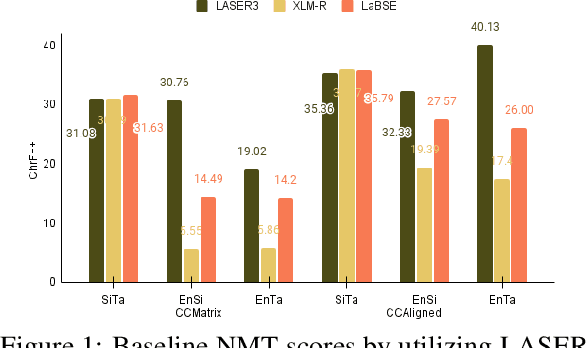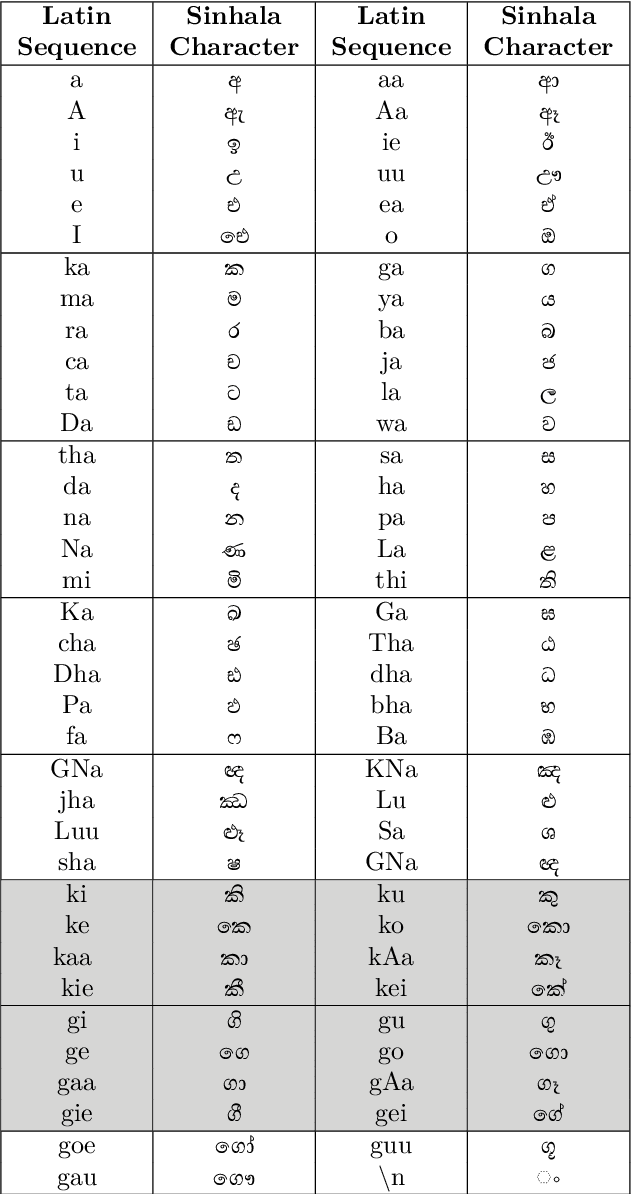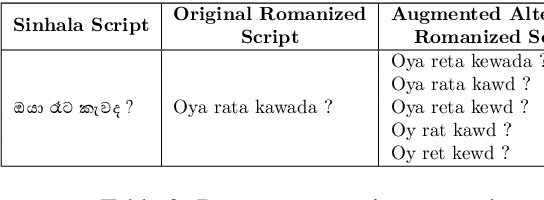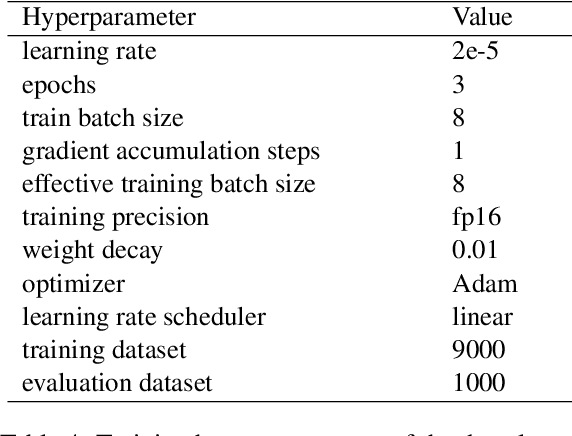Nisansa de Silva
Department of Computer Science & Engineering, University of Moratuwa, Sri Lanka
SinLlama -- A Large Language Model for Sinhala
Aug 12, 2025Abstract:Low-resource languages such as Sinhala are often overlooked by open-source Large Language Models (LLMs). In this research, we extend an existing multilingual LLM (Llama-3-8B) to better serve Sinhala. We enhance the LLM tokenizer with Sinhala specific vocabulary and perform continual pre-training on a cleaned 10 million Sinhala corpus, resulting in the SinLlama model. This is the very first decoder-based open-source LLM with explicit Sinhala support. When SinLlama was instruction fine-tuned for three text classification tasks, it outperformed base and instruct variants of Llama-3-8B by a significant margin.
Utilizing Multilingual Encoders to Improve Large Language Models for Low-Resource Languages
Aug 12, 2025Abstract:Large Language Models (LLMs) excel in English, but their performance degrades significantly on low-resource languages (LRLs) due to English-centric training. While methods like LangBridge align LLMs with multilingual encoders such as the Massively Multilingual Text-to-Text Transfer Transformer (mT5), they typically use only the final encoder layer. We propose a novel architecture that fuses all intermediate layers, enriching the linguistic information passed to the LLM. Our approach features two strategies: (1) a Global Softmax weighting for overall layer importance, and (2) a Transformer Softmax model that learns token-specific weights. The fused representations are mapped into the LLM's embedding space, enabling it to process multilingual inputs. The model is trained only on English data, without using any parallel or multilingual data. Evaluated on XNLI, IndicXNLI, Sinhala News Classification, and Amazon Reviews, our Transformer Softmax model significantly outperforms the LangBridge baseline. We observe strong performance gains in LRLs, improving Sinhala classification accuracy from 71.66% to 75.86% and achieving clear improvements across Indic languages such as Tamil, Bengali, and Malayalam. These specific gains contribute to an overall boost in average XNLI accuracy from 70.36% to 71.50%. This approach offers a scalable, data-efficient path toward more capable and equitable multilingual LLMs.
Improving the quality of Web-mined Parallel Corpora of Low-Resource Languages using Debiasing Heuristics
Feb 26, 2025



Abstract:Parallel Data Curation (PDC) techniques aim to filter out noisy parallel sentences from the web-mined corpora. Prior research has demonstrated that ranking sentence pairs using similarity scores on sentence embeddings derived from Pre-trained Multilingual Language Models (multiPLMs) and training the NMT systems with the top-ranked samples, produces superior NMT performance than when trained using the full dataset. However, previous research has shown that the choice of multiPLM significantly impacts the ranking quality. This paper investigates the reasons behind this disparity across multiPLMs. Using the web-mined corpora CCMatrix and CCAligned for En$\rightarrow$Si, En$\rightarrow$Ta and Si$\rightarrow$Ta, we show that different multiPLMs (LASER3, XLM-R, and LaBSE) are biased towards certain types of sentences, which allows noisy sentences to creep into the top-ranked samples. We show that by employing a series of heuristics, this noise can be removed to a certain extent. This results in improving the results of NMT systems trained with web-mined corpora and reduces the disparity across multiPLMs.
Linguistic Analysis of Sinhala YouTube Comments on Sinhala Music Videos: A Dataset Study
Jan 28, 2025



Abstract:This research investigates the area of Music Information Retrieval (MIR) and Music Emotion Recognition (MER) in relation to Sinhala songs, an underexplored field in music studies. The purpose of this study is to analyze the behavior of Sinhala comments on YouTube Sinhala song videos using social media comments as primary data sources. These included comments from 27 YouTube videos containing 20 different Sinhala songs, which were carefully selected so that strict linguistic reliability would be maintained and relevancy ensured. This process led to a total of 93,116 comments being gathered upon which the dataset was refined further by advanced filtering methods and transliteration mechanisms resulting into 63,471 Sinhala comments. Additionally, 964 stop-words specific for the Sinhala language were algorithmically derived out of which 182 matched exactly with English stop-words from NLTK corpus once translated. Also, comparisons were made between general domain corpora in Sinhala against the YouTube Comment Corpus in Sinhala confirming latter as good representation of general domain. The meticulously curated data set as well as the derived stop-words form important resources for future research in the fields of MIR and MER, since they could be used and demonstrate that there are possibilities with computational techniques to solve complex musical experiences across varied cultural traditions
Sinhala Transliteration: A Comparative Analysis Between Rule-based and Seq2Seq Approaches
Dec 31, 2024



Abstract:Due to reasons of convenience and lack of tech literacy, transliteration (i.e., Romanizing native scripts instead of using localization tools) is eminently prevalent in the context of low-resource languages such as Sinhala, which have their own writing script. In this study, our focus is on Romanized Sinhala transliteration. We propose two methods to address this problem: Our baseline is a rule-based method, which is then compared against our second method where we approach the transliteration problem as a sequence-to-sequence task akin to the established Neural Machine Translation (NMT) task. For the latter, we propose a Transformer-based Encode-Decoder solution. We witnessed that the Transformer-based method could grab many ad-hoc patterns within the Romanized scripts compared to the rule-based method. The code base associated with this paper is available on GitHub - https://github.com/kasunw22/Sinhala-Transliterator/
Instruct-DeBERTa: A Hybrid Approach for Aspect-based Sentiment Analysis on Textual Reviews
Aug 23, 2024Abstract:Aspect-based Sentiment Analysis (ABSA) is a critical task in Natural Language Processing (NLP) that focuses on extracting sentiments related to specific aspects within a text, offering deep insights into customer opinions. Traditional sentiment analysis methods, while useful for determining overall sentiment, often miss the implicit opinions about particular product or service features. This paper presents a comprehensive review of the evolution of ABSA methodologies, from lexicon-based approaches to machine learning and deep learning techniques. We emphasize the recent advancements in Transformer-based models, particularly Bidirectional Encoder Representations from Transformers (BERT) and its variants, which have set new benchmarks in ABSA tasks. We focused on finetuning Llama and Mistral models, building hybrid models using the SetFit framework, and developing our own model by exploiting the strengths of state-of-the-art (SOTA) Transformer-based models for aspect term extraction (ATE) and aspect sentiment classification (ASC). Our hybrid model Instruct - DeBERTa uses SOTA InstructABSA for aspect extraction and DeBERTa-V3-baseabsa-V1 for aspect sentiment classification. We utilize datasets from different domains to evaluate our model's performance. Our experiments indicate that the proposed hybrid model significantly improves the accuracy and reliability of sentiment analysis across all experimented domains. As per our findings, our hybrid model Instruct - DeBERTa is the best-performing model for the joint task of ATE and ASC for both SemEval restaurant 2014 and SemEval laptop 2014 datasets separately. By addressing the limitations of existing methodologies, our approach provides a robust solution for understanding detailed consumer feedback, thus offering valuable insights for businesses aiming to enhance customer satisfaction and product development.
M2DS: Multilingual Dataset for Multi-document Summarisation
Jul 17, 2024Abstract:In the rapidly evolving digital era, there is an increasing demand for concise information as individuals seek to distil key insights from various sources. Recent attention from researchers on Multi-document Summarisation (MDS) has resulted in diverse datasets covering customer reviews, academic papers, medical and legal documents, and news articles. However, the English-centric nature of these datasets has created a conspicuous void for multilingual datasets in today's globalised digital landscape, where linguistic diversity is celebrated. Media platforms such as British Broadcasting Corporation (BBC) have disseminated news in 20+ languages for decades. With only 380 million people speaking English natively as their first language, accounting for less than 5% of the global population, the vast majority primarily relies on other languages. These facts underscore the need for inclusivity in MDS research, utilising resources from diverse languages. Recognising this gap, we present the Multilingual Dataset for Multi-document Summarisation (M2DS), which, to the best of our knowledge, is the first dataset of its kind. It includes document-summary pairs in five languages from BBC articles published during the 2010-2023 period. This paper introduces M2DS, emphasising its unique multilingual aspect, and includes baseline scores from state-of-the-art MDS models evaluated on our dataset.
Aspect-Based Sentiment Analysis Techniques: A Comparative Study
Jul 03, 2024Abstract:Since the dawn of the digitalisation era, customer feedback and online reviews are unequivocally major sources of insights for businesses. Consequently, conducting comparative analyses of such sources has become the de facto modus operandi of any business that wishes to give itself a competitive edge over its peers and improve customer loyalty. Sentiment analysis is one such method instrumental in gauging public interest, exposing market trends, and analysing competitors. While traditional sentiment analysis focuses on overall sentiment, as the needs advance with time, it has become important to explore public opinions and sentiments on various specific subjects, products and services mentioned in the reviews on a finer-granular level. To this end, Aspect-based Sentiment Analysis (ABSA), supported by advances in Artificial Intelligence (AI) techniques which have contributed to a paradigm shift from simple word-level analysis to tone and context-aware analyses, focuses on identifying specific aspects within the text and determining the sentiment associated with each aspect. In this study, we compare several deep-NN methods for ABSA on two benchmark datasets (Restaurant14 and Laptop-14) and found that FAST LSA obtains the best overall results of 87.6% and 82.6% accuracy but does not pass LSA+DeBERTa which reports 90.33% and 86.21% accuracy respectively.
SHADE: Semantic Hypernym Annotator for Domain-specific Entities -- DnD Domain Use Case
Jun 29, 2024Abstract:Manual data annotation is an important NLP task but one that takes considerable amount of resources and effort. In spite of the costs, labeling and categorizing entities is essential for NLP tasks such as semantic evaluation. Even though annotation can be done by non-experts in most cases, due to the fact that this requires human labor, the process is costly. Another major challenge encountered in data annotation is maintaining the annotation consistency. Annotation efforts are typically carried out by teams of multiple annotators. The annotations need to maintain the consistency in relation to both the domain truth and annotation format while reducing human errors. Annotating a specialized domain that deviates significantly from the general domain, such as fantasy literature, will see a lot of human error and annotator disagreement. So it is vital that proper guidelines and error reduction mechanisms are enforced. One such way to enforce these constraints is using a specialized application. Such an app can ensure that the notations are consistent, and the labels can be pre-defined or restricted reducing the room for errors. In this paper, we present SHADE, an annotation software that can be used to annotate entities in the high fantasy literature domain. Specifically in Dungeons and Dragons lore extracted from the Forgotten Realms Fandom Wiki.
Shoulders of Giants: A Look at the Degree and Utility of Openness in NLP Research
Jun 10, 2024Abstract:We analysed a sample of NLP research papers archived in ACL Anthology as an attempt to quantify the degree of openness and the benefit of such an open culture in the NLP community. We observe that papers published in different NLP venues show different patterns related to artefact reuse. We also note that more than 30% of the papers we analysed do not release their artefacts publicly, despite promising to do so. Further, we observe a wide language-wise disparity in publicly available NLP-related artefacts.
 Add to Chrome
Add to Chrome Add to Firefox
Add to Firefox Add to Edge
Add to Edge